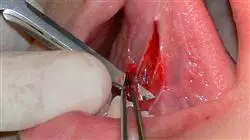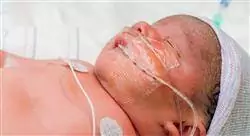University certificate
Scientific endorser

The world's largest faculty of nursing”
Introduction to the Program
New pediatric emergency scenarios encourage us to propose new refresher programs that meet the real needs of experienced professionals, so that they can implement advances in emergency patient care for children"
This Pediatric Emergency Nursing program includes theoretical knowledge and updates, but also provides instruction in pediatric advanced life support techniques, pediatric airway management, venous access and administration of drugs in appropriate doses, or immobilization of the pediatric polytraumatized patient, among other skills, to ensure immediate and high-quality care in the pediatric age group.
Furthermore, the fact that pediatric patient are different to adult emergency patients in a number of ways, necessitates education for pediatric emergency services and nursing professionals who work in them, in order to provide individualized and quality health care.
As such, it is necessary to update nursing professionals so that they have the competencies, skills and attitudes that will enable them to approach and pediatric emergencies in all forms and at all levels of care.
This Masters Degree in Pediatric Emergency Nursing, offers professionals the opportunity to get up to date in the approach and intervention of the most important pediatric emergencies, establishing key elements for the care of patients in critical condition and the implementation of different emergency care diagnostic and treatment techniques. In addition, it addresses organizational aspects of pediatric emergency services and the provision of personnel and material, with emphasis on their differential characteristics.
This Masters Degree in Pediatric Emergency Nursing includes real clinical cases and exercises to bring the development of the program to daily practice"
This Masters Degree in Pediatric Emergency Nursing contains the most complete and up-to-date scientific program on the market. The most important features include:
- Clinical cases presented by experts in the different specialties
- Its graphic, schematic and eminently practical content is designed to provide scientific and healthcare information in the medical disciplines that are essential for professional practice
- New diagnostic-therapeutic developments on the nursing professional's actions in the most frequent pediatric emergencies, both cardiorespiratory and infectious, digestive, neurological, etc., with specific sections in each module on nursing techniques and procedures according to age: airway aspiration, gastric lavage in poisoning, catheterization, immobilization of the polytraumatized patient, among others
- Includes pediatric nursing triage, and pediatric advanced life support techniques, based on the latest ILCOR 2015 recommendations
- Workshops on invasive techniques for the critically ill patient that are essential to work with in the emergency department: how to perform an intraosseous puncture, which drugs and doses to prepare in the rapid intubation sequence, how to manage a difficult airway, etc.
- An algorithm-based interactive learning system for decision-making in the clinical situations presented throughout the course
- Clinical practice guidelines for each emergency. These guides follow the scientific and pedagogical criteria of the scientific societies of reference in emergency medicine
- All of this will be complemented by theoretical lessons, questions to the expert, debate forums on controversial topics, and individual reflection assignments
- Content available from any device with Internet connection
This Masters Degree is the best investment you can make when selecting a refresher program, for two reasons: in addition to updating your knowledge in Pediatric Emergency Nursing, you will obtain a qualification issued by TECH Global University"
This professionalizing program is designed to update nursing professionals who develop their functions in the field of pediatric patient emergency care, and who require a high level of qualification. The contents are based on the latest scientific evidence, and oriented in an educational way to integrate theoretical knowledge into nursing practice, and the theoretical-practical elements will facilitate knowledge updates and decision-making in patient management.
Thanks to the multimedia content, developed with the latest educational technology, nursing professionals will benefit from situated and contextual learning, i.e., a simulated environment that will provide immersive learning programmed to train in real situations.
This program is designed around Problem-Based Learning, whereby the professional must try to solve the different professional practice situations that arise throughout the program. For this reason, students will be assisted by an innovative, interactive video system created by renowned and experienced experts in pediatric emergencies with extensive teaching experience.
Expand your knowledge through this Masters Degree in Pediatric Emergency Nursing, in a practical way and adapted to your needs"

This Masters Degree gives you the opportunity to practice in simulated environments, which provide immersive learning programmed to train in real situations"
Why study at TECH?
TECH is the world’s largest online university. With an impressive catalog of more than 14,000 university programs available in 11 languages, it is positioned as a leader in employability, with a 99% job placement rate. In addition, it relies on an enormous faculty of more than 6,000 professors of the highest international renown.

Study at the world's largest online university and guarantee your professional success. The future starts at TECH”
The world’s best online university according to FORBES
The prestigious Forbes magazine, specialized in business and finance, has highlighted TECH as “the world's best online university” This is what they have recently stated in an article in their digital edition in which they echo the success story of this institution, “thanks to the academic offer it provides, the selection of its teaching staff, and an innovative learning method aimed at educating the professionals of the future”
A revolutionary study method, a cutting-edge faculty and a practical focus: the key to TECH's success.
The most complete study plans on the university scene
TECH offers the most complete study plans on the university scene, with syllabuses that cover fundamental concepts and, at the same time, the main scientific advances in their specific scientific areas. In addition, these programs are continuously being updated to guarantee students the academic vanguard and the most in-demand professional skills. In this way, the university's qualifications provide its graduates with a significant advantage to propel their careers to success.
TECH offers the most comprehensive and intensive study plans on the current university scene.
A world-class teaching staff
TECH's teaching staff is made up of more than 6,000 professors with the highest international recognition. Professors, researchers and top executives of multinational companies, including Isaiah Covington, performance coach of the Boston Celtics; Magda Romanska, principal investigator at Harvard MetaLAB; Ignacio Wistumba, chairman of the department of translational molecular pathology at MD Anderson Cancer Center; and D.W. Pine, creative director of TIME magazine, among others.
Internationally renowned experts, specialized in different branches of Health, Technology, Communication and Business, form part of the TECH faculty.
A unique learning method
TECH is the first university to use Relearning in all its programs. It is the best online learning methodology, accredited with international teaching quality certifications, provided by prestigious educational agencies. In addition, this disruptive educational model is complemented with the “Case Method”, thereby setting up a unique online teaching strategy. Innovative teaching resources are also implemented, including detailed videos, infographics and interactive summaries.
TECH combines Relearning and the Case Method in all its university programs to guarantee excellent theoretical and practical learning, studying whenever and wherever you want.
The world's largest online university
TECH is the world’s largest online university. We are the largest educational institution, with the best and widest online educational catalog, one hundred percent online and covering the vast majority of areas of knowledge. We offer a large selection of our own degrees and accredited online undergraduate and postgraduate degrees. In total, more than 14,000 university degrees, in eleven different languages, make us the largest educational largest in the world.
TECH has the world's most extensive catalog of academic and official programs, available in more than 11 languages.
Google Premier Partner
The American technology giant has awarded TECH the Google Google Premier Partner badge. This award, which is only available to 3% of the world's companies, highlights the efficient, flexible and tailored experience that this university provides to students. The recognition as a Google Premier Partner not only accredits the maximum rigor, performance and investment in TECH's digital infrastructures, but also places this university as one of the world's leading technology companies.
Google has positioned TECH in the top 3% of the world's most important technology companies by awarding it its Google Premier Partner badge.
The official online university of the NBA
TECH is the official online university of the NBA. Thanks to our agreement with the biggest league in basketball, we offer our students exclusive university programs, as well as a wide variety of educational resources focused on the business of the league and other areas of the sports industry. Each program is made up of a uniquely designed syllabus and features exceptional guest hosts: professionals with a distinguished sports background who will offer their expertise on the most relevant topics.
TECH has been selected by the NBA, the world's top basketball league, as its official online university.
The top-rated university by its students
Students have positioned TECH as the world's top-rated university on the main review websites, with a highest rating of 4.9 out of 5, obtained from more than 1,000 reviews. These results consolidate TECH as the benchmark university institution at an international level, reflecting the excellence and positive impact of its educational model.” reflecting the excellence and positive impact of its educational model.”
TECH is the world’s top-rated university by its students.
Leaders in employability
TECH has managed to become the leading university in employability. 99% of its students obtain jobs in the academic field they have studied, within one year of completing any of the university's programs. A similar number achieve immediate career enhancement. All this thanks to a study methodology that bases its effectiveness on the acquisition of practical skills, which are absolutely necessary for professional development.
99% of TECH graduates find a job within a year of completing their studies.
Master's Degree in Pediatric Emergencies for Nursing
TECH Global University presents the Master's Degree in Pediatric Emergency Nursing, a program designed for those professionals who wish to specialize in the care of children in emergency situations. Our online classes give you the opportunity to acquire the necessary knowledge and skills from the comfort of your home, without compromising the quality of your education. In this Master's Degree, you will learn the latest techniques and protocols for pediatric emergency care, ensuring a quick and effective response to critical situations. Our professors, experts in the field of Pediatric Nursing, will guide you every step of the way, sharing their experience and knowledge to enrich your learning. Online classes offer you the flexibility to organize your study time according to your needs. You will be able to access the didactic materials at any time and place, allowing you to combine your personal and professional responsibilities. In addition, you will have interactive tools, explanatory videos of the topics by teachers, interactive summaries, lectures with experts on the subject, multimedia resources and more, to facilitate your understanding of the content and help you put into practice what you have learned.
100% online Pediatric Emergency Nursing Specialization
Upon completion of the Master's Degree in Pediatric Emergency Care for Nursing, you will be prepared to face challenging scenarios in pediatric emergency care. You will master stabilization and intensive care techniques, as well as effective communication with children and their families in stressful situations. Your learning will make you a highly trained and valued professional in the field of Pediatric Nursing - don't miss the opportunity to expand your knowledge and excel in this field! Join TECH Global University and acquire the necessary skills to provide quality care in critical moments for children.








